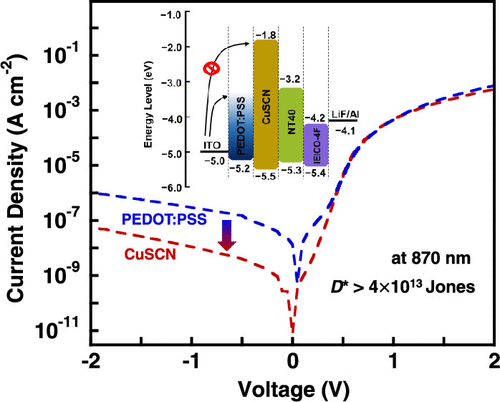当前位置:
X-MOL 学术
›
ACS Appl. Mater. Interfaces
›
论文详情
Our official English website, www.x-mol.net, welcomes your
feedback! (Note: you will need to create a separate account there.)
Copper Thiocyanate as an Anode Interfacial Layer for Efficient Near-Infrared Organic Photodetector
ACS Applied Materials & Interfaces ( IF 8.3 ) Pub Date : 2020-12-22 , DOI: 10.1021/acsami.0c18260
Zhenqiang Huang 1 , Zhiming Zhong 1, 2 , Feng Peng 1, 2 , Lei Ying 1, 2 , Gang Yu 1 , Fei Huang 1, 2 , Yong Cao 1
ACS Applied Materials & Interfaces ( IF 8.3 ) Pub Date : 2020-12-22 , DOI: 10.1021/acsami.0c18260
Zhenqiang Huang 1 , Zhiming Zhong 1, 2 , Feng Peng 1, 2 , Lei Ying 1, 2 , Gang Yu 1 , Fei Huang 1, 2 , Yong Cao 1
Affiliation

|
Interfacial modification between the electrode and the overlying organic layer has significant effects on the charge injection and collection and thus the device performance of organic photodetectors. Here, we used copper(I) thiocyanate (CuSCN) as the anode interfacial layer for organic photodetector, which was inserted between the anode and an organic light-sensitive layer. The CuSCN layer processed with ethyl sulfide solution presented similar optical properties to the extensively used anode interlayer of poly(3,4-ethylenedioxythiophene):poly(styrene sulfonate) (PEDOT:PSS), while the relatively shallow conduction band of CuSCN resulted in a much higher electron-injection barrier from the anode and shunt resistance than those of PEDOT:PSS. Moreover, the CuSCN-based device also exhibited an increased depletion width for the PEDOT:PSS-based device, as indicated by the Mott–Schottky analysis. These features lead to the dramatically reduced dark current density of 2.7 × 10–10 A cm–2 and an impressively high specific detectivity of 4.4 × 1013 cm Hz1/2 W–1 under −0.1 V bias and a working wavelength of 870 nm. These findings demonstrated the great potential of using CuSCN as an anode interfacial layer for developing high-performance near-infrared organic photodetectors.
中文翻译:

硫氰酸铜作为高效近红外有机光电探测器的阳极界面层
电极与上层有机层之间的界面改性对电荷注入和收集以及有机光电探测器的器件性能具有重要影响。在这里,我们使用硫氰酸铜(I)作为有机光电探测器的阳极界面层,该层插入阳极和有机感光层之间。硫化乙基溶液处理的CuSCN层具有与广泛使用的聚(3,4-乙撑二氧噻吩):聚(苯乙烯磺酸盐)(PEDOT:PSS)阳极中间层相似的光学性能,而相对较浅的CuSCN导带导致与PEDOT:PSS相比,来自阳极和分流电阻的电子注入势垒要高得多。此外,对于基于PEDOT:PSS的器件,基于CuSCN的器件还展现出更大的耗尽宽度,如Mott–Schottky分析所示。这些功能导致暗电流密度大大降低,为2.7×10–10 A cm –2,在-0.1 V偏置和870 nm的工作波长下,具有4.4×10 13 cm Hz 1/2 W –1的高比探测率。这些发现证明了使用CuSCN作为阳极界面层开发高性能近红外有机光电探测器的巨大潜力。
更新日期:2021-01-13
中文翻译:

硫氰酸铜作为高效近红外有机光电探测器的阳极界面层
电极与上层有机层之间的界面改性对电荷注入和收集以及有机光电探测器的器件性能具有重要影响。在这里,我们使用硫氰酸铜(I)作为有机光电探测器的阳极界面层,该层插入阳极和有机感光层之间。硫化乙基溶液处理的CuSCN层具有与广泛使用的聚(3,4-乙撑二氧噻吩):聚(苯乙烯磺酸盐)(PEDOT:PSS)阳极中间层相似的光学性能,而相对较浅的CuSCN导带导致与PEDOT:PSS相比,来自阳极和分流电阻的电子注入势垒要高得多。此外,对于基于PEDOT:PSS的器件,基于CuSCN的器件还展现出更大的耗尽宽度,如Mott–Schottky分析所示。这些功能导致暗电流密度大大降低,为2.7×10–10 A cm –2,在-0.1 V偏置和870 nm的工作波长下,具有4.4×10 13 cm Hz 1/2 W –1的高比探测率。这些发现证明了使用CuSCN作为阳极界面层开发高性能近红外有机光电探测器的巨大潜力。































 京公网安备 11010802027423号
京公网安备 11010802027423号